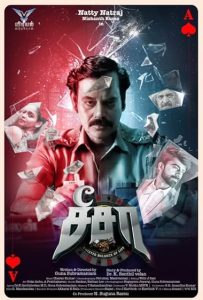When Seesaw (2025) sneaks into your heart even after it falls flat on paper
It is rare for a Tamil language crime thriller to leave Indian audiences feeling simultaneously intrigued and underwhelmed, yet Seesaw manages exactly that emotional tug. Released on 3 January 2025, the film set out to explore the dark interplay between mental illness, embalmers, murder and moral decay in a striking household mystery. Directed and written by Guna Subramaniam, and produced under Tamil cinema’s Vidiyal Studios banner, it features Natty Subramaniam as Inspector Mugilan, Nishanth Russo as Aadhavan, and Padine Kumar as Malavika. The film unfolds when a servant is found dead, the businessman husband and his wife go missing, and Mugilan is called in from leave to hunt down answers. Yet for all that setup, critics across outlets (including The Times of India giving it just 2/5) say the thriller’s beats don’t quite land as promised. Fans who seek depth might feel cheated, but there’s something about that imbalance which says more than neat criticism ever will.
Read also: Eddington (2025)
The unseen underbelly: embalming, gaming addiction and quiet obsession
You won’t find this spelled out in the trailers, but deeper discussion threads and articles reveal that Seesaw delves into two niche obsessions rarely seen in Tamil cinema: the embalming profession, and young Indian men addicted to online games. In a surprising twist commented on by Pentagan Media, one of the suspects is an embalmer, a friend of the missing husband, whose job is chillingly described as preserving bodies for grieving families while enabling suspense around fresh corpses. Interwoven with that is the theme of gambling through online games, which the film suggests can push vulnerable youngsters toward extreme psychological states. That makes Seesaw feel rooted in contemporary anxieties, especially in Indian metro homes where parents watch gamers turn into ghosts of themselves, offering emotional resonance beyond cliché police procedure scenes.
Audience pulses: WhatsApp reaction chains and YouTube echoes
Scroll past the reviews and you’ll find a different story from comment sections on YouTube and Reddit to private WhatsApp groups, Seesaw has struck nerves. On reviewers’ videos, comments range from “he’s such a psycho” to “edge-of-seat until interval”, showing that those who came hoping for a mind bending spectacle at least felt something real. IMDb users averaged around 6.6/10, with about 1,100 votes, suggesting a mixed but engaged response. On Indian social platforms, fans argue over the portrayal of mental health, particularly bipolar disorder. Some blame the script for tokenizing the protagonist’s breakdown, while others credit the performance and the setting for sparking necessary conversations around family stigma and mental institutions. That emotional tension has made Seesaw a film people want to discuss even if not unanimously.
Also read: Haan Main Pagal Haan (2025)
Why Chennai neighbourhoods whispered and murmured about Seesaw
In Chennai and Tamil Nadu, cinemas buzzed with chatter beyond box office returns. Local viewer reactions on Jsk Prime Media and other YouTube public review compilations show how everyday audiences reacted, the kind of vocal murmur you’d hear in auto rickshaws or at college canteens after watching the film. There’s pride that actors like Natty Subramaniam and Nishanth Russo are taking risks with offbeat scripts, and tear jerking concern that mainstream Tamil cinema still treats mental health with buckets of melodrama. Some family audiences relate to the idea of a brother or son spiraling due to trauma, while others feel the investigative structure was more predictable than powerful. That mixed but emotional response shows the film’s undercurrent impact, it may not succeed clinically, but it gets people talking in real time about taboo fears.
Read more: Hari Hara Veera Mallu (2025)
Real talk from experts: where Seesaw students and sociologists collide
While mainstream critics slammed the pacing and plot logic (the script hinges on questions like why an obviously bipolar character wasn’t institutionalized sooner), sociologists and psychology aware bloggers dug deeper. They noted the missed opportunity to explore how families in India ignore early warning signs of mental illness, leading to tragedy. From an expert viewpoint, Seesaw lightly touches on stigma in middle class homes, and the contrast between private desperation and public restraint in Indian society. The embalmer character especially was seen as symbolic, someone who distances himself from death yet becomes enmeshed in it. It’s the kind of symbolism scholars online flagged as quietly brave, even if the story around it falters. So while critics complained of disjointed editing and pacing, opinion pieces online praised its ambition to probe cultural taboos with mainstream storytelling.
Read more: Thalaivan Thalaivii (2025)
Bottom line: why Seesaw matters even if it doesn’t thrill
If you’re wondering why a film described as “forgettable” by critics and given low professional scores still keeps appearing in your WhatsApp reel or YouTube algorithm, the answer is emotional friction. Seesaw may not be slick or seamless, but it scratches at Indian anxieties: mental illness and family shame, modern tech addiction, intimate betrayal, suspicion in everyday relationships. For Tamil audiences and urban Indians, that matters. The debate is not only whether the climax lands, but what the film dared whisper between scenes. In our streaming era attention economy, a film like this works less as polished entertainment and more as a conversation trigger.
Key highlights Indian audiences are talking about:
- A rare spotlight on embalming in cinema and how death is ritualized in domestic spaces
- The mental health angle, especially bipolar disorder’s portrayal and family denial
- Teenage gaming pressure as emotional fuel in a crime thriller
- Strong performances by Natty and Nishanth Russo that hold the film’s loose ends together
In the end, Seesaw tells us more about what we fear and hide in Indian homes than about clever plot mechanics. It’s a film many click on out of curiosity, stay for the unsettling questions, and walk away still talking.

